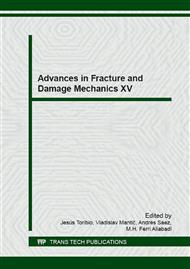p.30
p.34
p.38
p.42
p.46
p.50
p.54
p.58
p.62
A Dual BEM Formulation for Thermo-Magneto-Piezo-Electric 2D Fracture Problems
Abstract:
A hypersingular approach of the boundary element formulation -BEM- is presented for the analysis of the temperature in fracture problems of multifield materials. A fundamental solution based on the extended Stroh formalism is considered. Hypersingular integrals arising in the traction boundary and heat flux integral equations are computed through a regularization technique causing that only regular integrals are computed numerically. The generality of the method allows the study of 2D solids with no shape restrictions. Generalized intensity factors -IFs- are accurately computed from nodal values next to crack tip. Finally, the possibilities of the presented approach are discussed in order to apply it for the assessment of the influence of temperature in fracture problems for materialspresenting mechanical, magnetic and/or electrical coupling
Info:
Periodical:
Pages:
46-49
Citation:
Online since:
September 2016
Price:
Сopyright:
© 2016 Trans Tech Publications Ltd. All Rights Reserved
Share:
Citation:


